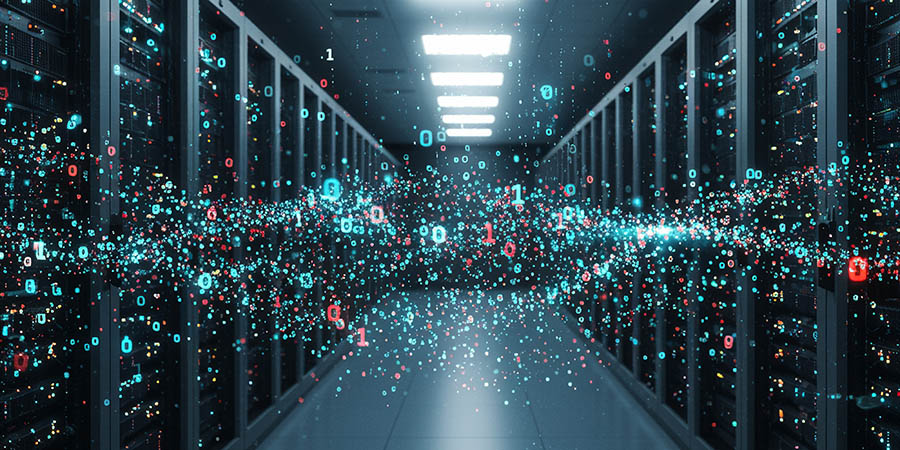The global data center market is vast and rapidly growing. By the end of 2025, there will be 6,111 public data centers worldwide, 5,544 colocation sites, and 567 hyperscale sites. These facilities have become foundational to enterprise digital transformation, enabling the delivery of advanced technologies such as 5G, cloud computing, blockchain, and artificial intelligence (AI).
To manage the enormous volumes of data generated by these technologies, modern data center networks comprise a wide range of components, including servers, storage systems, networking hardware, and advanced software for efficient resource management and control. A data center’s reliability hinges on its robust support infrastructure, including power subsystems, uninterruptible power supplies (UPS), backup generators, cooling systems, fire suppression mechanisms, and comprehensive physical security.
Investments in data center infrastructure are crucial for building strong digital foundations, supporting both public and private sector goals in digital services, automation, and data analytics.
Also Read: AI to Double Data Center Electricity Consumption by 2030
Infrastructure Upgrades to Meet Growing Demands
The shift towards AI and machine learning (ML) is dramatically reshaping infrastructure requirements. Traditional data centers, designed for 5–10 kilowatts per rack, are now struggling to keep pace with AI applications demanding 60 kilowatts or more. AI also generates significantly more data, requiring expanded capacity, already accounting for about 20% of global data center usage.
According to the International Energy Agency (IEA), data center energy consumption is projected to more than double by 2030, driven largely by AI workloads. This growth presents challenges for global energy security and emission reduction goals. Additionally, technologies like 5G, the Internet of Things (IoT), and the metaverse are creating demand for low-latency computing, further driving the growth of edge data centers. Meanwhile, user devices, increasingly equipped with ML accelerators, may influence future energy requirements in unpredictable ways.
To meet the Middle East’s demands, Umniah has constructed the largest Tier III data center in Jordan, certified by the Uptime Institute, positioning the region as a digital hub through resilient, advanced infrastructure. Digital Dubai is advancing toward an AI-powered data center economy, reflecting its broader ambition to become a global leader in intelligent infrastructure and digital services. Infobip’s data center in Saudi Arabia is boosting regional capacity and ensuring better performance and scalability for clients in the Kingdom and surrounding countries.
e& Carrier & Wholesale has expanded its Tier III SmartHub to Abu Dhabi, enhancing connectivity and offering cutting-edge infrastructure to meet growing regional demand. Nabil Baccouche, e& Group Chief Carrier & Wholesale Officer, noted:
The hi-tech infrastructure and strategic location of Abu Dhabi will be a valuable asset to our customers and the wider business community.
At the same time, e&'s collaboration with Intel is fostering the development of distributed edge data centers, combining sustainability with innovation to deliver low-latency infrastructure at scale.
The Anatomy of Data Centers
Data centers are built around networks of computing and storage resources that deliver shared applications and data. Key components include routers, switches, firewalls, storage systems, servers, and application delivery controllers.
Data center interconnect (DCI) technologies link two or more data centers over various distances using high-speed, packet-optical connections. This enables seamless data sharing, backup redundancy, and disaster recovery. DCI technology supports a range of connectivity solutions, from simple point-to-point links to sophisticated reconfigurable optical add-drop multiplexer (ROADM) networks and open-line systems using multi-vendor components. The most effective DCI transport technologies use next-generation coherent optics, delivering speeds of up to 800 Gbps per wavelength. This allows physically separated facilities to operate as a unified infrastructure, sharing workloads and resources efficiently.
Some enterprises use DCI to link internal facilities, while others connect to partners, cloud providers, or colocation centers. Some DCI requirements prioritize high capacity and automation, while others are optimized using energy efficient or specific form factors. In the Middle East, DCI adoption is accelerating. Nokia’s deployment of a DCI solution in 2021 marked a key milestone in regional connectivity. Building on this, du and UAE-IX created the first dedicated data center interconnection platform in the UAE, laying the foundation for seamless inter-data center communication. In Oman, the Oman-IX is enhancing the Sultanate’s interconnectivity strategy, while Omantel’s 400GbE DCI service, implemented alongside Ciena, delivers bandwidth and scalability.
Identifying Data Center Locations
Even cloud-based workloads ultimately run on physical servers located somewhere. The geographical placement of these servers impacts performance, cost, compliance, security, and resilience. Enterprises must weigh up numerous factors when selecting data center locations, and few regions can fulfill every requirement. Efficient cloud connectivity, proximity to industry ecosystems, network availability, a stable renewable grid, and climate conditions are some of the areas that need attention when choosing the location for data centers.
center3 is strategically expanding its footprint through a robust network of cable landing stations across Saudi Arabia, spanning Jeddah, Yanbu, Duba, Haql, and Al Khobar. According to center3, these landing points are critical in linking terrestrial and subsea infrastructure, positioning Saudi Arabia as a central hub for data flow between continents.
By bridging east and west, the extended network through Saudi Arabia offers a low-latency route for traffic crossing between the continents. This is a game-changer for global communications, offering speed and efficiency that are critical for modern digital operations.
Further strengthening its global presence, center3’s acquisition of CMC Networks is accelerating its growth strategy, unlocking access to over 110 service locations across Africa and the Middle East. According to Eng. Thamer Alfadda, SVP, Mobily Wholesale and Carrier Services, “As digital transformation and cloudification accelerate both at the business and consumer level, global internet traffic is doubling every two to three years.”
This necessitates the availability of state-of-the-art domestic and international connectivity infrastructure, along with data centers where the content is locally hosted and interconnected at internet exchange points (IXPs).
Evolving Data Center Design
To optimize operations, data center operators are adopting advanced software, connectivity solutions, and sensor technologies. AI and ML are increasingly being used for real-time optimization and automation.
For example, Nokia’s SR Linux facilitates highly automated data center networking utilizing a model-driven management architecture, robust telemetry, and a Kubernetes-based platform. Features like intent-based operations, pre/post-checks, and digital twins help ensure reliability and reduce complexity. Huawei, another major player, is building intelligent computing infrastructure. Its solutions support clusters with up to 100,000 GPUs, meeting the needs of next-generation AI workloads. Moreover, the adoption of MTP® connectors is revolutionizing data center design by increasing speed, density, and reliability.
Also Read: Majid AlNaqbi Showcases the Dual Engines Driving du’s Data Center Transformation
Energy and Sustainability Challenges
As energy demands rise, sustainability has become a critical issue. New reporting regulations are scrutinizing data center carbon footprints. According to the Uptime Institute, these regulations will challenge many operators to prove the practicality of their sustainability commitments, potentially affecting profitability and operational flexibility. On a positive note, in an exclusive interview with Telecom Review, David Erlich, Consulting Director at Sofrecom, explained that, “From a carbon footprint standpoint, the energy used by data centers appears greener.”
The move to hyperscalers has protected the digital world from an emission explosion.
Safeguarding Data and Regional Growth
Since 2017, the Middle East has seen a fourfold increase in data center infrastructure investment.
Efforts are underway in the Arab world to develop unified data protection regulations, similar to the European Union’s General Data Protection Regulation (GDPR). Such legislation aims to foster trust and align digital growth with cultural values, enhancing the region’s appeal for foreign investment.
While many enterprises are moving to the cloud, transparency and accountability still keep a majority of workloads in private facilities. An Uptime Institute survey found that 58% of organizations remain cautious about fully adopting public cloud solutions. Policy environments also play a key role. Supportive regulations that encourage innovation and data protection can significantly boost data center investment.
In an effort to safeguard data and regional growth, Cisco established a data center to ensure cloud-delivered security in Saudi Arabia and help customers protect their users, infrastructure, and investments against threat actors. The new data center supports Cisco’s cloud services, including its secure service edge (SSE) solution, Cisco Secure Access.
Also Read: Investors Flock to Data Centers: GCC Emerging as Global Leader
Building Talent for the Future
Skilled labor is essential for efficient and profitable data center operations. For instance, in Saudi Arabia, Tuwaiq Academy, in partnership with the Uptime Institute, offers a six-month, intensive, data center training program. It prepares national talent for roles in advanced data center management across sectors. The program includes application-based bootcamps, globally recognized certifications, and practical training in specialized labs. Participants gain expertise in data center operations, design, and analytics, helping bridge talent gaps in this fast-growing field. Interestingly, data center personnel requirements are forecast to grow globally from about 2 million full time employees (FTE) in 2019 to nearly 2.3 million by 2025, suggesting a huge potential for future growth.
A Transformative Region for Data Center Growth
The influence of data centers extends beyond digital convenience; they are central to economic development and technological leadership. Countries that lead in data center infrastructure are often at the forefront of the digital economy, empowered by robust computing, storage, and networking capabilities. The Middle East has shown marked improvement in the development of data centers.
In the UAE, the cloud market is booming, with major providers such as Microsoft, AWS, Oracle Cloud, e&, and G42 Cloud competing in a concentrated and dynamic environment. The International Monetary Fund (IMF) has affirmed Saudi Arabia's leading position in the number of data centers among Gulf Cooperation Council (GCC) countries, reflecting the Kingdom’s significant progress in developing digital infrastructure. Other countries such as Oman, Qatar, and Kuwait have made considerable progress in data center development in line with their respective national digital initiatives.










